Guide to All Things Topical
?? Welcome friends! This is an introductory guide to topical medicine – created alongside a webinar of the same name. My goal with this guide is to show you what’s possible when we look at the whole picture of health through the lens of topical medicine.
The biggest question of topical medicine is… Will this work?
Yes, well, maybe. First we need to understand the skin, what sort of chemical constituents can get in, ways to enhance absorption, what sort of conditions we can treat at the topical level… (you see where I’m going)…
Well, that’s what this guide is for.
Let’s dig in! At the bottom, I’ve included details about my brand new online program, opening March 21 2022 – All Things Topical! → More details here.
IN THIS GUIDE
- About Topical Medicine
- The Skin — Cool facts & its “selective permeability”
- Absorption – How things get in
- Enhancers of Absorption
- Wound Healing
- Inflammation
- Common Skin Conditions
- The right questions to ask
- Case Study
- Herbal Spotlight — Can you guess who? ?
- About the program: All Things Topical
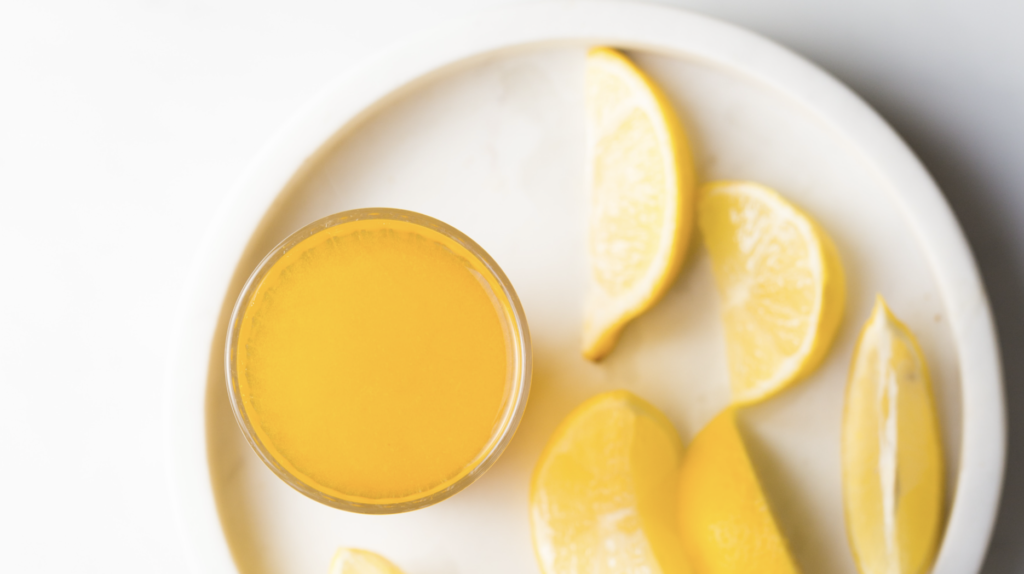
About Topical Medicine
One of the things to consider about this modality of herbalism is that making topical medicine takes more time. It’s not as simple as making a tincture. Since we’ve invested a lot of time and energy we want our medicine to be effective. We also don’t want to be wasteful of the plants who’ve given up their lives to help make our medicine.
It’s important to know that not all herbs work topically, and the timing of when to use topical medicine is really important as well.
With all that said, there are time-honored processes that our teachers and our ancestors have worked with topical medicines. It can be as simple as chewing up a plant and putting it on your arm and it can be much more complicated as well, depending on what you want to achieve.
Timing
Timing is important. If you apply a topical remedy at the wrong time you can cause some big problems. That’s why I’ve included a cautionary tale or two in this guide.
Absorption
You might spend a lot of time making your topical medicine. Well, does it work? Will it get to the place you want it to? If you just throw it together without understanding how absorption works then your medicine might not work.
The Whole Person
Treating skin conditions is like any other, we need to look at the whole person. The case study I go into below addresses how everything is connected, yet a topical lens helps us see things from an interesting new angle.
Knowing HOW and WHY topical medicine works will help you overcome a dependence on recipes and give you a map for making effective medicine and treating conditions.
So my friends, read on. We’ll start with a little A&P (anatomy and physiology) of the skin, principles of absorption, and then move on to herbs and medicine making.
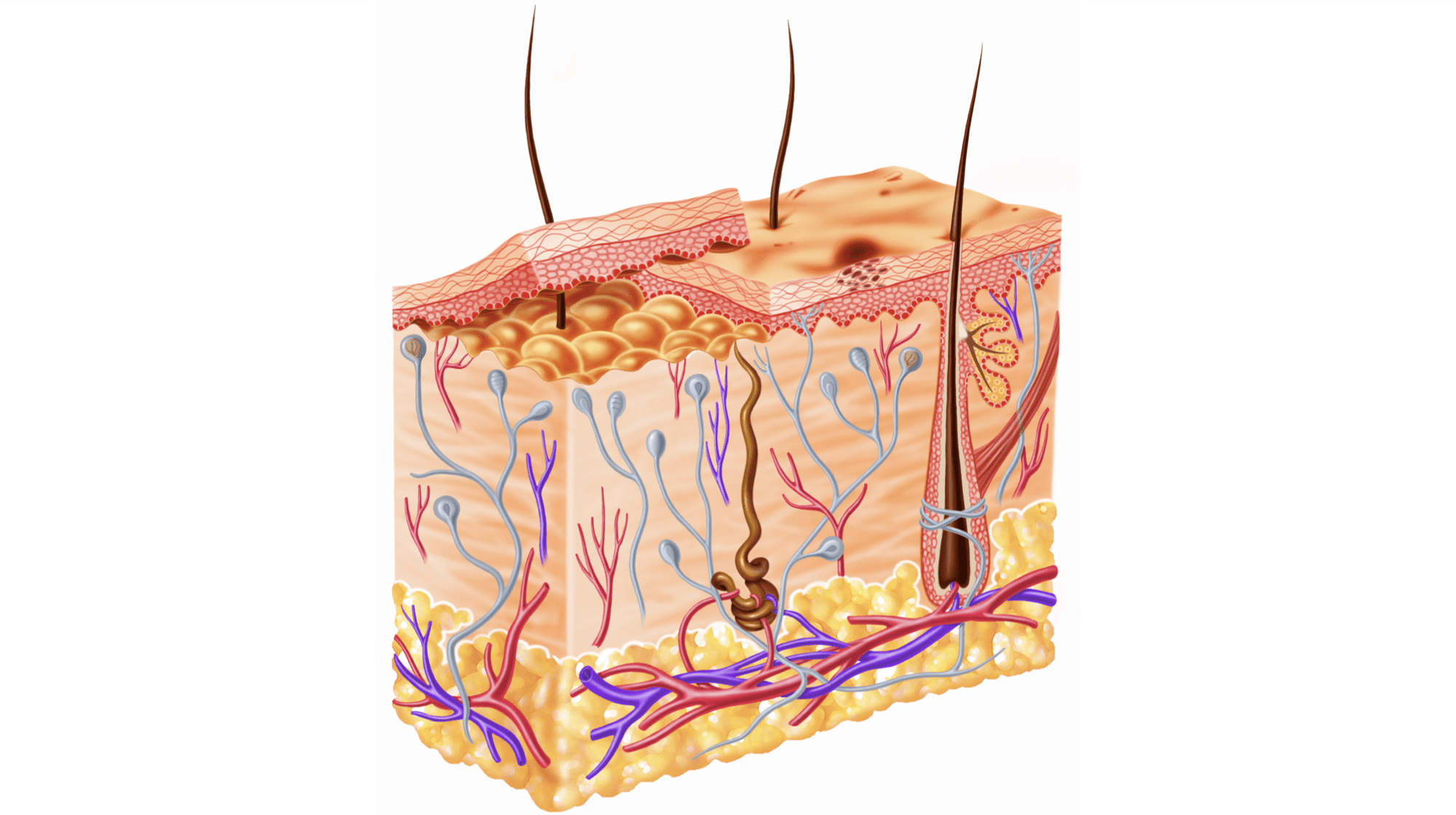
Meet the Skin
This picture is what you see in your classic A & P or biology book of the layers of the skin. Let’s start with some fun facts, then we’ll talk about how things get in.
So here are some cool facts.
- Your skin is the largest organ in your body.
- It’s the third largest organ for absorbing things. The whole entire surface area is around 22 square feet – almost the size of my 4×6 dry erase board.
- An area of skin the size of a quarter has: 3 million cells, 100 sweat glands, 50 nerve endings, three feet of blood vessels, three feet of lymphatic vessels. and 19,000 sensory receptors.
- You make and shed your skin 840 times over a 70 year lifespan. I like to say that we kick a snake’s butt.
- We shed 1 million cells per hour.
- We lose 1.5 pounds of skin a year – that’s 40 pounds of skin you shed over your lifetime… And most of it can be found in your house as dust. ?
So this is the organ that we are interfacing with. It’s good to start with the fun facts to get excited about what’s next!
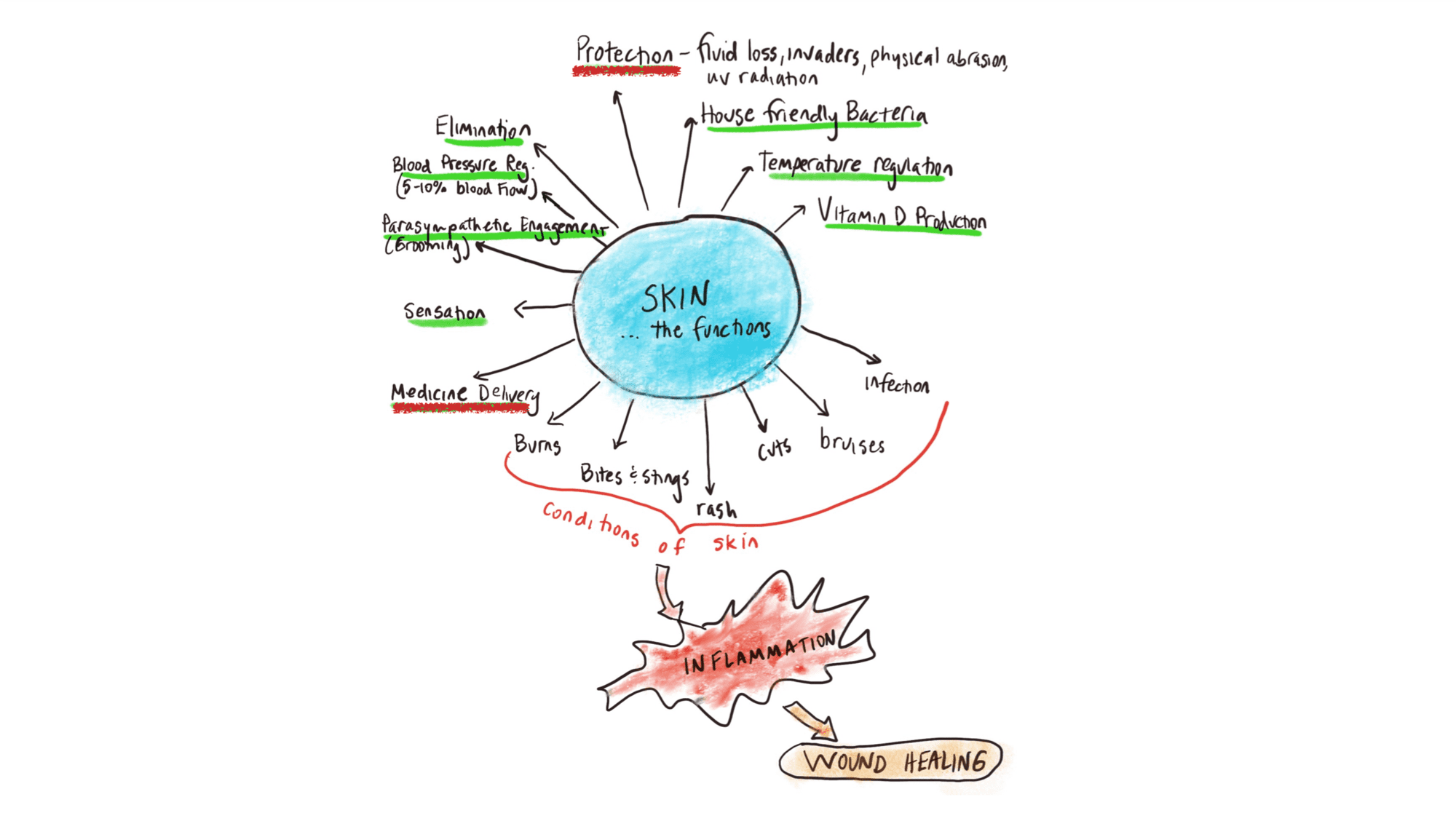
Functions of the Skin
If we start to look at the functions of the skin (as shown in the diagram above) you can see all the many functions.
But the ones that we’re going to focus on today are protection.
You can think of our skin as our own “leathers,” right? We’re walking around with our own protective leather. One of the things that it protects us against is damaging the delicate tissues underneath. If you fall and scrape your arm on the cement, it’s not damaging the tender little connective tissue, or the muscle, or even the bone underneath, because I’ve got my leather that’s protecting the underlying tissues.
The skin protects us from fluid loss. That’s one of the reasons third-degree burns can be a cause of death – because we lose control of regulating water loss and we lose large volumes of water through evaporation.
The skin also protects us against UV radiation, which we aren’t going to get into in this guide, but there’s lots more to cover here.
Finally, there are also foreign invaders. The skin is a barrier. It’s a castle that protects us from foreign invaders trying to get in and eat us or compete for our food.
The Skin and Absorption
When it comes to using topical medicine it’s important to understand absorption, or how things get in. The skin selectively absorbs, meaning, it’s permeable in such a way that only certain things are allowed in.
Why? Well, we can’t let everything in. Think about when you go to the gas station and you pump gas. If you didn’t have this barrier, that gasoline would absorb into the skin. We don’t want to let that carcinogen in. If our skin wasn’t selectively permeable, everything that you come into contact with would come in. If it didn’t let anything in, we wouldn’t have a reason to make topical medicines.
So it’s good that it’s selectively permeable!
Here’s a diagram, and some additional details:
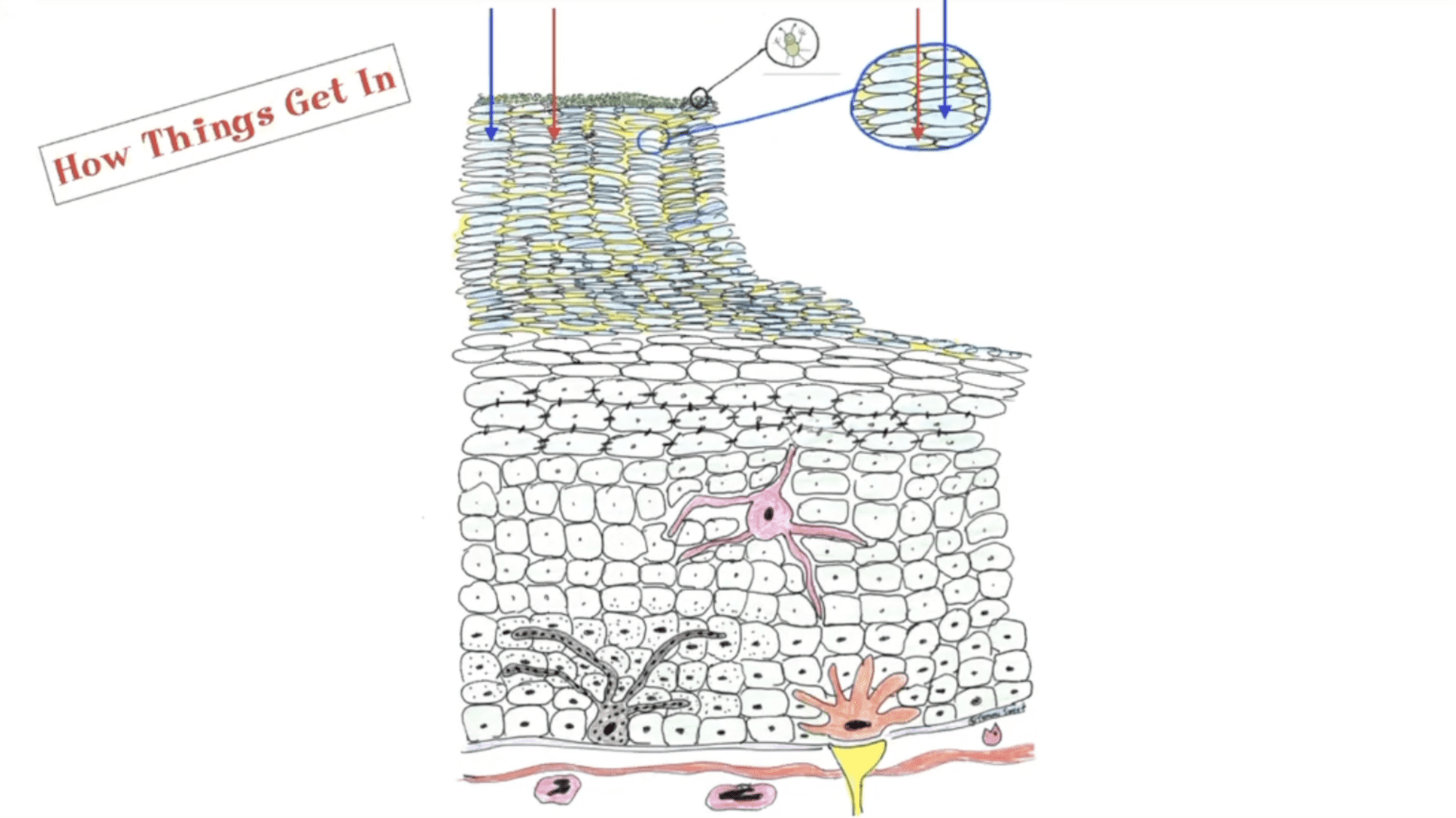
The arrows in the diagram show the different pathways – all the blocks are the skin cells.
The top 25 to 30 layers of stacks of skin are dead. There are cells filled with a protein called keratin that is actually waterproofing to the outside. The cells are like bricks (the blue in the diagram) and the mortar of our skin cells (yellow in-between the cells) is a cholesterol-based oil that makes it waterproof, and less permeable.
The way things get into our skin is they either go through all the cells, right straight through all the cell membranes (the blue arrow), or they go in between through the mortar (the path of the red arrow). The third way, which I don’t have the diagram here, is to sneak through the hair follicle.
You can see from this diagram that we need our topically applied herbs to be able to go from the top all the way down to the layer that is damaged.
That’s anywhere from 60 to 100 cells layers that our herbs have to diffuse — through which is really important to consider, especially in comparison to our digestive system or in our respiratory system where it might just be two cell layers.
Now let’s talk about absorption, and how to get things in…
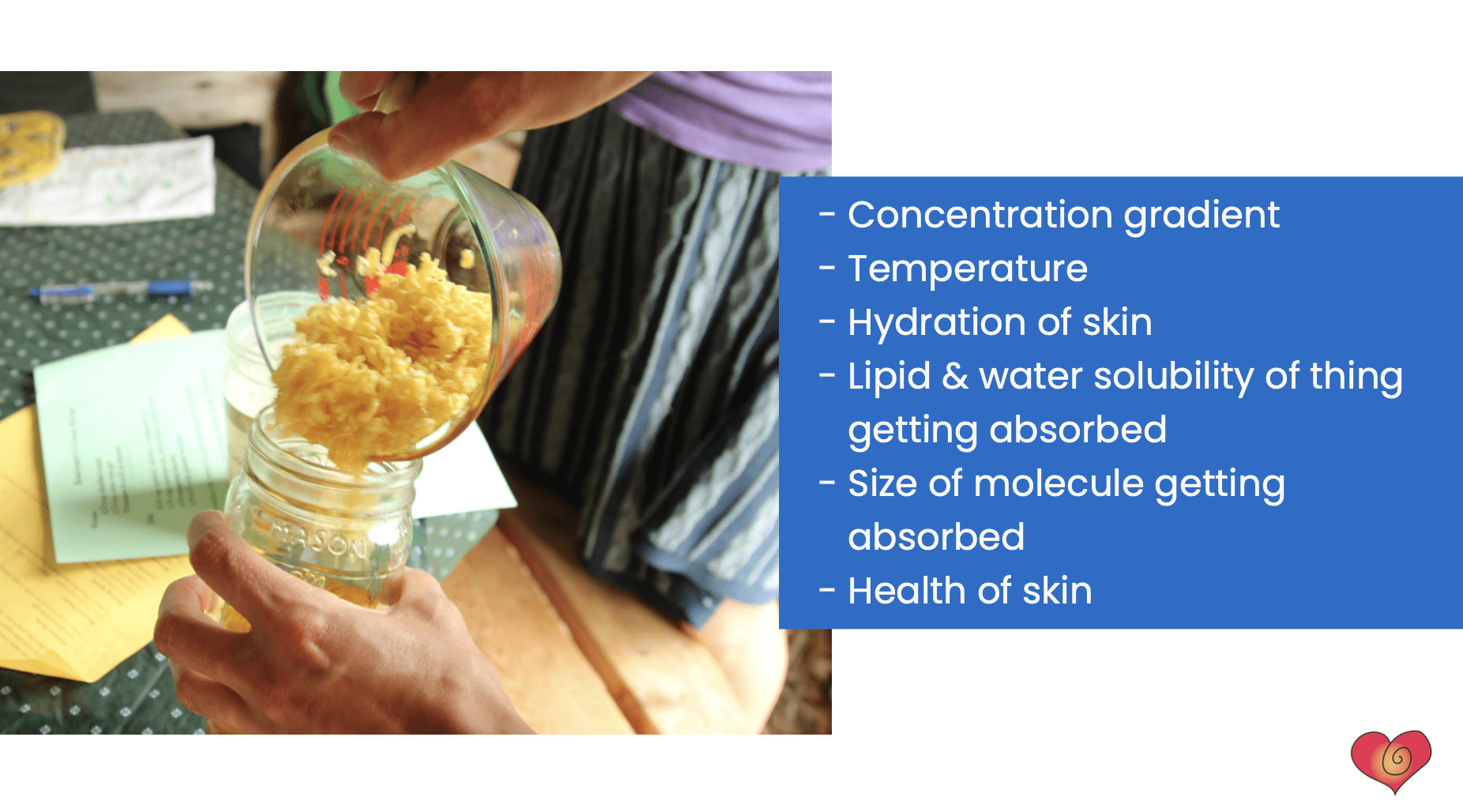
Absorption
This is really important. Not understanding how we get things in leads to ineffective topical medicine. On the flip side, understanding this unlocks all kinds of potential for your healing work and medicine making.
Concentration Gradient
Let’s say you are using Arnica oil. There should be more of the Arnica constituents on the top of your skin than there are in the skin. That, in a nutshell, is the concentration gradient.
If you did a cholesterol-based salve (because the “mortar” of our skin is cholesterol), it wouldn’t get in because there’s no concentration gradient. One of the laws of our universe is things diffuse from areas where there’s lots of it to where there’s little.
Temperature
So what do you think… is a cold temperature or warm temperature going to allow more things to get in?
If you said warm… you’re right! Increasing the temperature will allow things to go in.
Hydration
The more hydrated your skin is, the better able we are to get herbs in. Taking a bath or a warm soak handles both temperature and hydration.
Lipid and Water Solubility of thing being absorbed
Briefly stated, we want substances that will both dissolve in a lipid or fat and also in water, because our skin contains both at the surface.
Size of the Molecule
The next thing is the size of the molecule you want to be absorbed. Now we’re getting into the geeky Brainy Smurf stuff ? But if you must know, anything with molecular weight, under 500, will absorb into the skin. Most of the constituents of the topical herbs that we use are below 500.
Molecular weight is definitely a chemical geek thing. You could go to “the Google” and ask “what is the molecular weight of CBD?” And it’s about 340… Yea, most of us probably don’t care, but I had to show off a little bit here!
Health of the Skin
The health of the skin is an important factor for absorption. If you have an open wound, things are going to get in… because your barrier is compromised! We don’t want to be applying herbs to open wounds. Unless you know the physiology of when it’s going to close off. The health of the skin is another important factor with absorption.
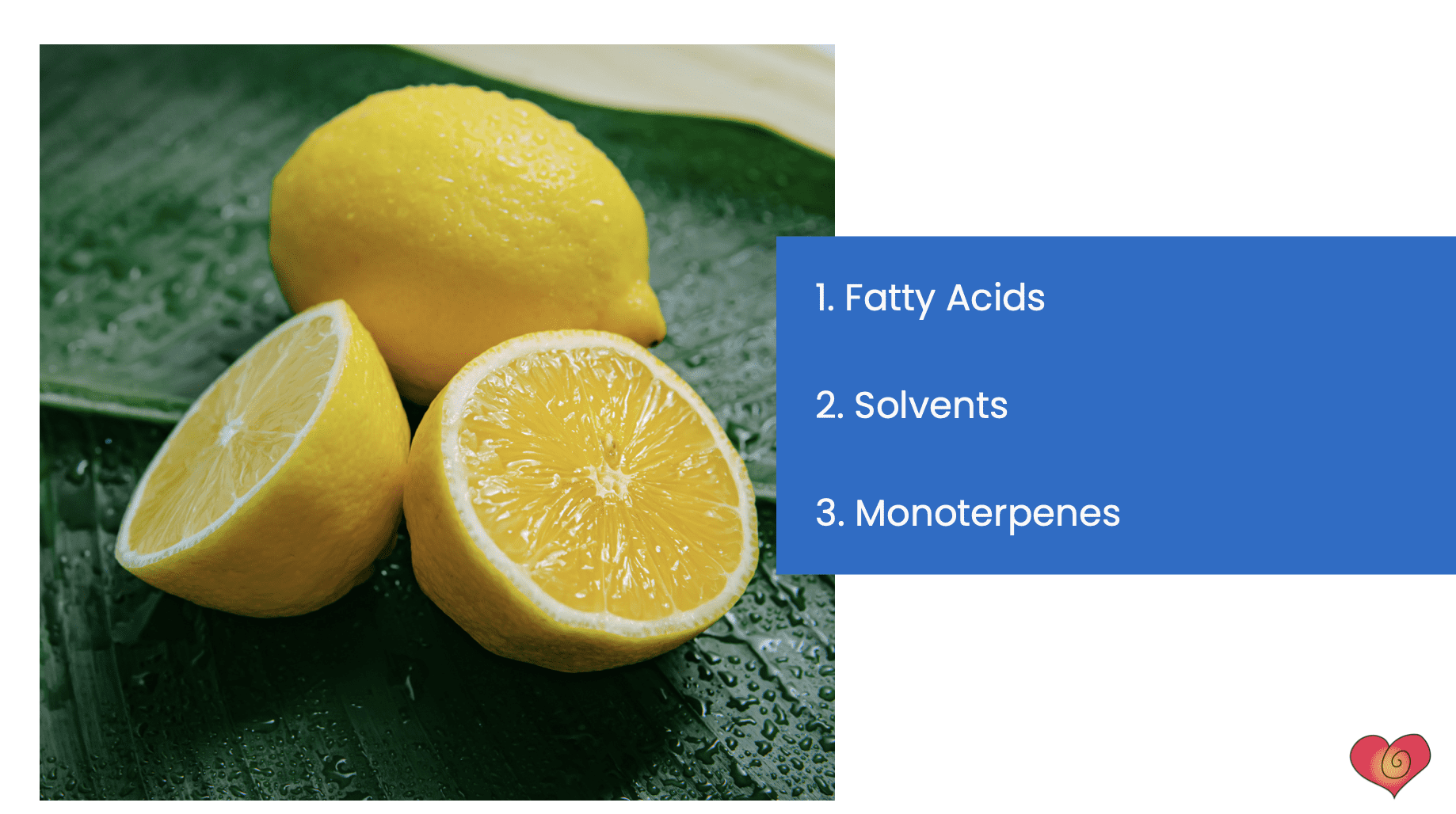
Enhancers of Absorption
What are the magical things that we can do to help our herbs get in?
Fatty Acid
The number one enhancer is fatty acid. Oils that are high in fatty acids actually increase absorption. There are many different oils you can work with of course. Many herbalists know and love working with olive oil. I’ve been doing a lot of research in preparation for my program, and as I was doing my research, I found out that sunflower oil is actually a better absorptive oil than olive oil! Sunflower oil is also great for me because it’s local, which aligns with my values of sourcing medicine where we live.
Solvents
The second way to enhance absorption is using a solvent that disrupts the surface of the skin and actually decreases the lipid layer a little bit. For example, think of a liniment — the alcohol actually disrupts the skin layer and removes some of the oil, and allows things to get in more easily.
Monoterpenes
Lastly, when it comes to absorption enhancers, it turns out there are some monoterpenes (essential oils) that actually increase the absorption of constituents. There are studies that showed a 34 fold increase in absorption based on monoterpene presence. So you’re probably asking… Okay, who are they?
One of them is limonene. You saw a lemon in the image above, but actually, the wild orange essential oil and grapefruit essential oil are higher in limonene than lemon is! Lemon is great as well though, of course. Another essential oil that’s full of monoterpenes that are helpful is Eucalyptus. Another is carvone monoterpene, which is found in spearmint.
Lastly, there is also caraway. Now, I wouldn’t make a caraway essential oil or use one, but spearmint I would definitely use.
So let’s sum it up… what are the methods that help ensure my topical medicine is being absorbed?
- Using a fatty acid — like olive oil or sunflower oil.
- Adding an essential oil with helpful monoterpenes.
- Creating a liniment (using alcohol or another solvent) would help as well.
So that’s absorption!
The next important thing to understand before using topical medicine is wound healing, and timing. I’ll explain and share a cautionary tale in the next section…
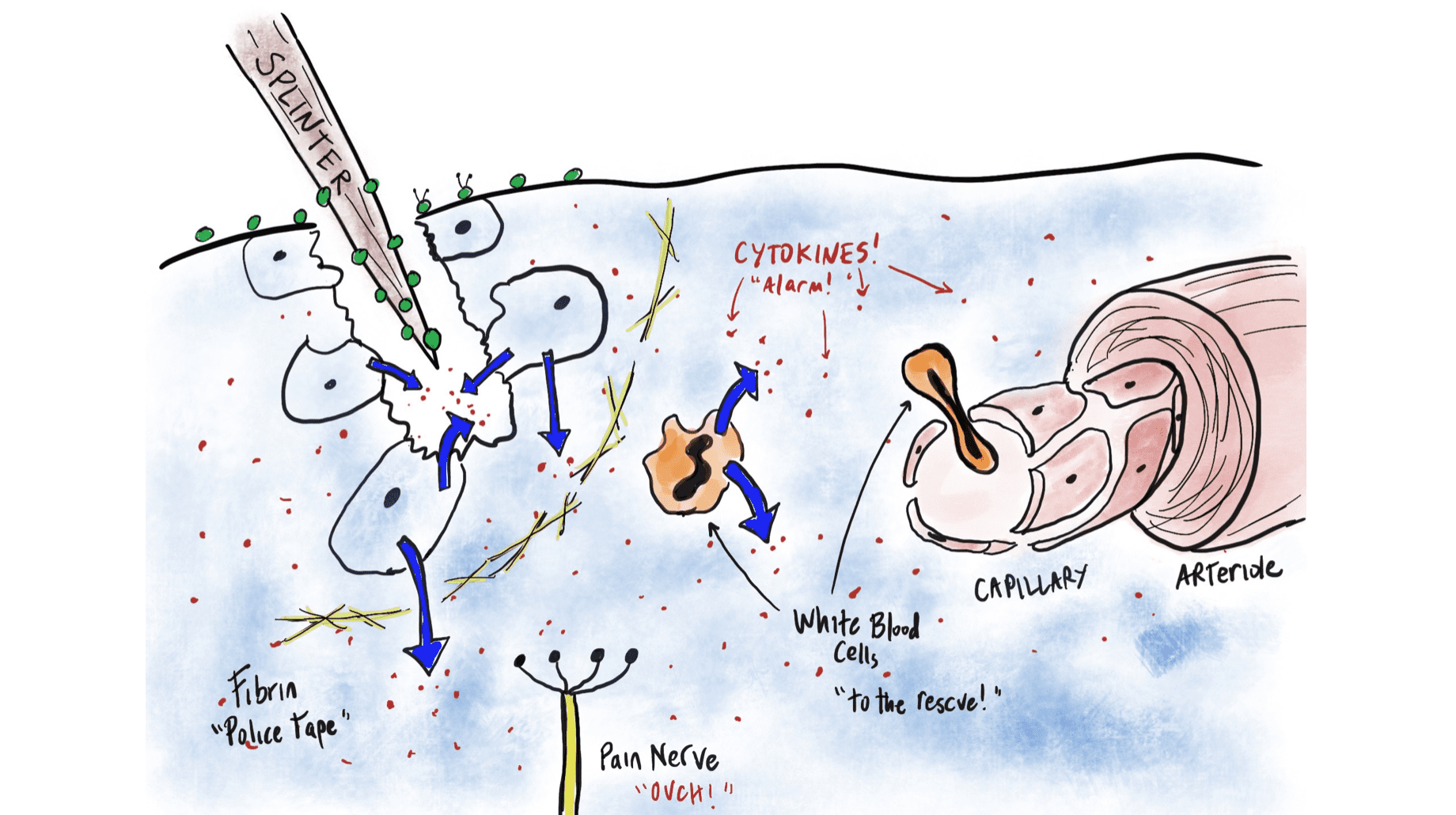
Wound Healing
Look a the image above, specifically where the splinter is. You can see the little cells that broke open to repair the damage, the cells actually have to divide, and then they move towards each other to fill in a hole. And once they touch, then they start reproducing and stacking to go up.
The whole process of wound healing is set in motion by inflammation. A lot of people think inflammation = bad, but it’s a necessary healing step for every single wound! Not just in the skin, but through your whole body.
Inflammation is the first response for all healing
Basically, a way to think of inflammation (refer again to the drawing above) is that when these cells break open they release chemicals, cytokines, that send out a signal that says, “Hey, send in help! We need help!” This attracts white blood cells to the area and the white blood cells start releasing chemicals to attract more help.
Next up come the phagocytes. These big PacMan-like helpers come in and they eat any foreign invader and dead cells. They’re the ones who start to clean up the wounded area.
The benefit of inflammation is that this help comes in.
What are the signs and symptoms of inflammation?
1. Redness + Heat + Swelling
Those chemicals mentioned above get released and they diffuse over to the blood vessel. They vasodilate the blood vessel — the blood vessel gets bigger — which leads to more blood coming to the area, which makes it red. Blood is also warm, so it makes the area hot.
Additionally, those chemicals make the little teeny tiny capillaries leaky. This means white blood cells, fluid, oxygen, and nutrients can leak out… As that happens repair can start to happen, so with this “leaking” also comes the swelling.
2) Pain
The reason we have pain is because those little chemicals mentioned earlier can also bind to a pain nerve that signals pain. This happens to tell you to get off your ankle or not use your arm that has a wound in it.
Again, it’s so important to understand that inflammation is the number one necessary step for healing.
Well, then why am I told by my coach, my physical therapists, my doctor, my trainer? To do “RICE” — Rest, Ice Compression, Elevate? Why?
Why do they tell me to take ibuprofen? Because you’ve got to get back to work, you’ve got to get back on the playing field!
But the truth is that acute inflammation is healing – and there are really only a couple instances in which we should try and stop it.
When should I intervene and stop inflammation?
Acute inflammation lasts anywhere from three to seven days – if all is going well, it should peak at seven days, and then slowly start to diminish. This time frame of three to seven days depends on how bad the injury was how much damage was done.
- Number one, you can’t sleep. If you’re in so much pain, and there’s so much swelling that you can’t sleep, we need to help you sleep because sleep is a healing state.
- And number two (this is the reason that the doctor and the PT tell you to decrease inflammation) is because they’re worried it’s going to get so bad that it’s going to cause tissue damage.
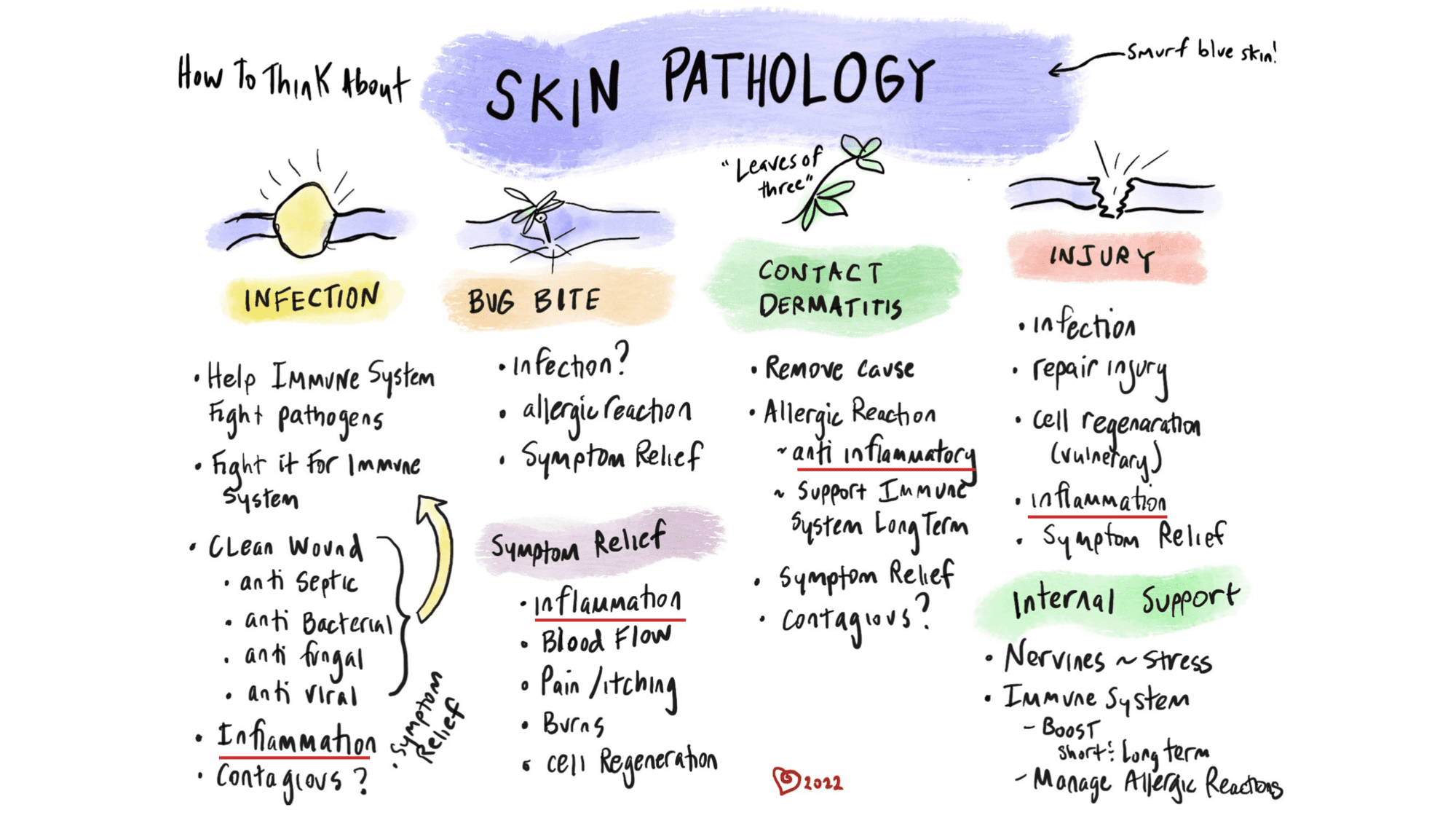
Common Skin Conditions
This was a fun little diagram that I made a number of years ago and then got to redraw the other day. What I like to do is think in the big picture…
Anybody that goes to a doctor or a dermatologist with a rash, they’re going to say that it’s some sort of dermatitis. These are some real rocket scientists here (heavy sarcasm alert) — because “derma” is the layer of the skin, and anything that ends in “itis” means inflammation… ?♀️
So dermatitis is inflammation of the skin. That’s what a rash is, and they’re going to give you topical cortisone to deal with it.
There. I’ve just saved you $150! ?
That’s the concept that Western medicine uses: Western medicine sees inflammation, decides it needs to tone it down and goes for the one solution it has: cortisone.
“Apply it, slather it on!” (That has its own detriment, which we can talk about in the full course “All Things Topical”…)
But there are herbs that reduce inflammation, too. For example, you could make an infusion of Arnica and apply it with a compress to decrease inflammation. We’ll dive in more to this in a bit.
The best approach I’ve found though is to ask some common questions to help get to the root of the issue:
How are you doing your laundry?
I worked at the Finger Lakes School of Massage for 16 years, and I taught anatomy and physiology. Inevitably, in every single program, someone would come up to my desk and be like, “I have this rash and I don’t know what it is”. Most times it would be a young person who has just left home and changed the way they are doing laundry. I would ask them about it and inevitably it would be an allergy to the soap that they were using. Now, if I were to give them cortisone, or even a topical herb to decrease inflammation it wouldn’t change the way they were doing laundry, and thus they would have the rash forever.
Have you been out in a field lately?
So one of the things, especially with skin conditions, is we get to be investigators ask questions about what we are coming into contact with that could be causing the reaction.
Other questions to ask might seem obvious, but again, we can develop allergies at any time. So in the summer months, “have you been out in a field lately? Do you know what poison ivy looks like?”
Is it contagious?
This question is really more of protection for you and your client … is it contagious?
Especially with topical, we need to be careful with sharing a container of medicine that we’ll be spreading all over our bodies. No double-dipping! Also, if you are the one applying the topical medicine to someone, you want to protect yourself from a possible contagious condition. This is a good place for wearing gloves.
Is an underlying issue from another system?
Is the cause of the rash topical only? Or a result of an overactive nervous system? Or in response to something they ate? Is the immune system overreacting?
As with all of our herbal studies, we need to get curious here!
Case Study – Eczema
A person comes to you – and they’ve got something going on with their hand.
The questions I’d ask are:
- Is this new? Did this just happen? Did you change anything recently? New gloves?
- Is this the only place you have the rash?
- Have you been out working in your garden?
As we start to look at this inflammation, we can see it’s dry. It’s red. And it’s a little flaky. And usually, it’s not just on their hands.
This is eczema. And there are different kinds of eczema. But this one is what’s called “atopic dermatitis.” And atopic means having a genetic tendency towards inflammation. That is the western science definition of it.
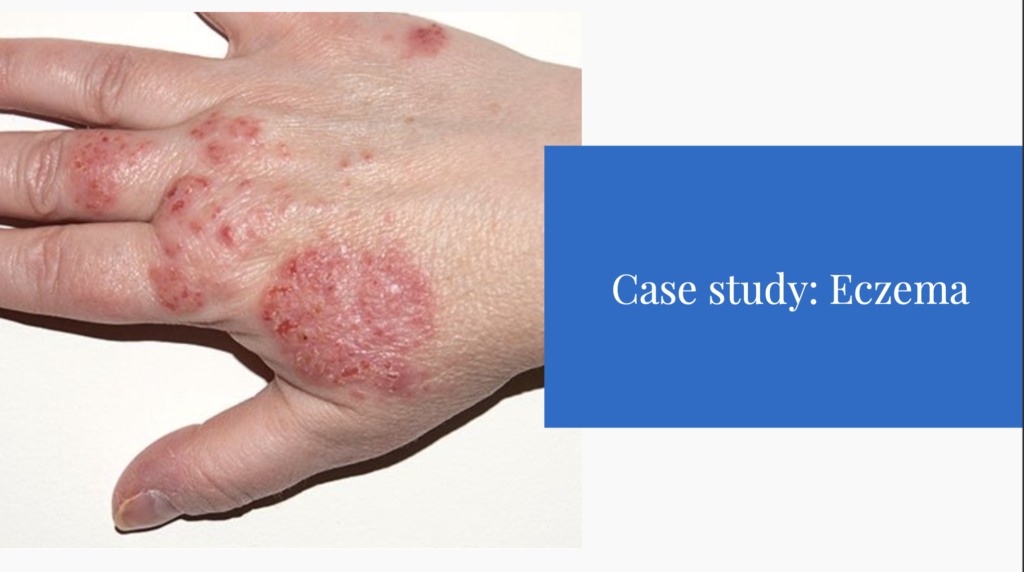
But… It’s now proven in biology, that only 5% of all diseases are genetically predetermined, and eczema isn’t one of them. The thing that makes us predetermine something like this is actually our environment.
And Eczema is a hard one to work with if you’re only treating topically. We could develop a really nice wash. We could create a soothing oil that would help with the redness and the inflammation. But in the case of eczema, we have an inflammatory reaction and an immune/allergic reaction to an underlying issue in our environment.
We call this hypersensitivity, the immune system is overreacting to either something that they came into contact with — something in the diet for example. Diet is something that is not treated by a lot of dermatologists. Dairy is a big one that can cause eczema. Then, we get into the whole thing of habits, and well… that’s a whole other thing!
I use eczema as an example because it illustrates the connection between skin conditions and the whole person.
Sure, we can develop topical medicines to apply. But we also want to help quiet the immune system, we want to remove the thing that is causing the reaction — for example, dairy and gluten. These are the big ones that will help diminish eczema when removed. Eczema can also be a response to stress, so we want to work with the nervous system.
So that’s an example of applying it all — a whole human, whole systems approach.
To bring it back to herbs, we would want to work with herbs that help the whole system get soothed and quieted.
This leads us to our favorite section…
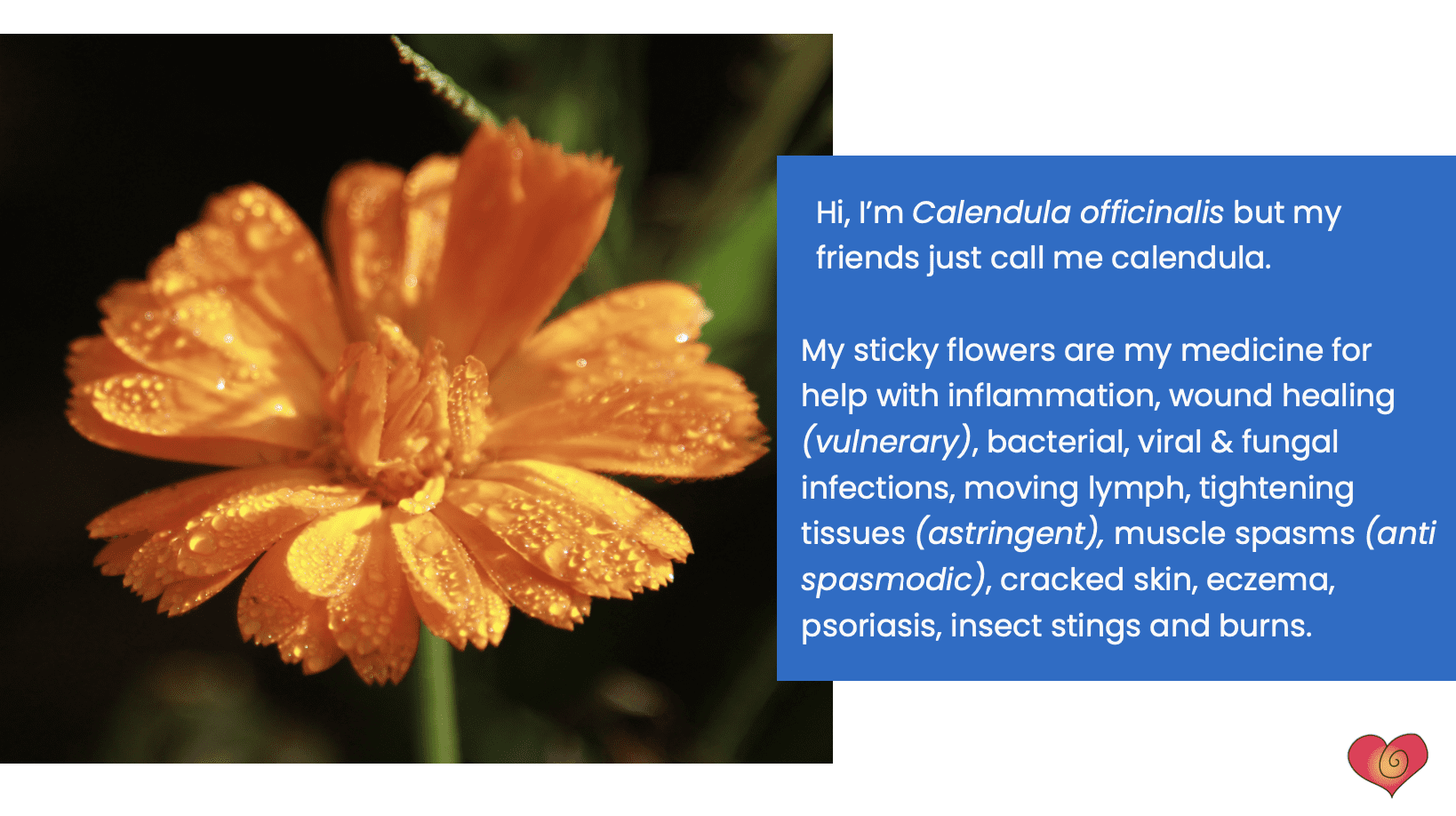
Herbal Spotlight – Calendula!
About 25 years ago when there used to be forums that were like email, I sent an email out to the New England Herbal Association.
I said what are your top 13 herbs?
And this was number one.
We have gallons of it dried because it’s awesome for making a really strong tea or strong infusion as a wound wash.
It’s antibacterial, antiviral, and anti-fungal – great for cleaning wounds. For example, I would use calendula when my cats would get in fights and I needed to clean a wound.
It’s also vulnerary – which means it stimulates cell growth. When you combine it with comfrey, it’s like they’re the Wonder Twins ?♀️?♂️ .
Together they actually increase the vulnerary capabilities beyond what they are individually.
Calendula is also anti-inflammatory and anti-spasmodic. On top of that, we call it an astringent because it helps to tighten the tissue — think of working with varicose veins topically. It’s good for eczema, cracked skin, psoriasis, insect stings, and burns.
What an amazing ally for topical medicine!
I highly recommend everyone have calendula on hand. It’s wonderful and easy to grow, you make infusions as needed, and it creates a beautiful oil.
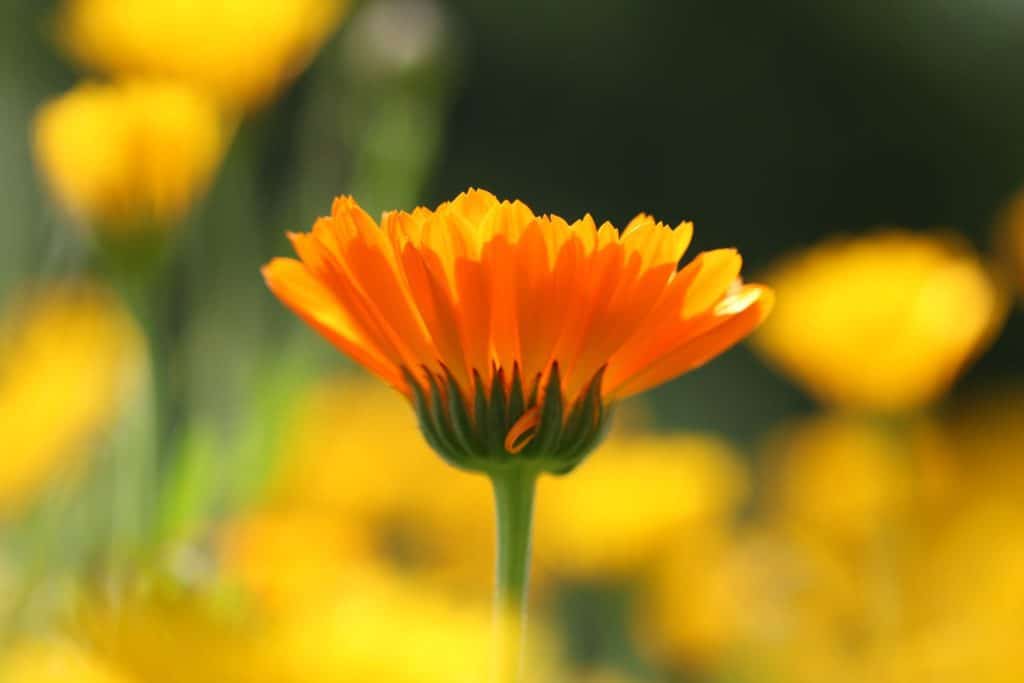
This is where I want to tell you a story…
A Cautionary Tale – Timing is everything
On the very first day I got my puppy she got bit by another dog, and there was a little wound on her nose. I had not studied herbs at this point, but I had this little comfrey, calendula, plantain salve (a superpower of every herbalist!)
So, I slathered some of it on her wound.
It was a puncture wound – and if you are an herbalist and you understand these things you are cringing right now at what I did…
What happened was this combination of herbs caused the top of the wound to grow so fast that it closed it off, and then left the little bacterial infection below to fester in this beautifully warm nutrient rich environment that could not escape. It caused an abscess the size of a silver dollar on my little puppy ?
It was because the wound healed too fast at the top — it didn’t heal from the bottom up and it was a prime environment for the bacteria to fester.
Yeah… So don’t do that!
It’s important to allow an open wound to heal over from the bottom up before applying a vulnerary herb.
All Things…
I hope by now you can see how important it is to go deep in topical medicine – that when we understand this area we can treat our whole-person in significant ways.
This overview should give you a sense of what’s possible, but it hardly scratched the surface. Some other topics to explore in greater depth;
- Advanced Physiology of the Pain Response
- The whole medicine making process
- Anatomy & Physiology of the skin including…
- Other ways of increasing absorption
- What herbs can absorb at the skin level and why
- Materia Medica of my favorite topical herbs
- Anatomy & Physiology of Wound Healing of the Four Tissue Types
- Advanced Physiology of Inflammation
- Common Pathologies found in the skin
- Basic Topical Medicine Making skills
- Infused oils
- Properties of commonly used carrier oils
- Temperature ranges for extraction
- Tips on methods for extraction
All of these things are covered in my new program, All Things Topical. I’m SO EXCITED to share this with you (if you can’t tell by the graphic).

Introducing, All Things Topical!
So, why did I put this course together?
At this point in my career, I want to teach things that I’m excited about. Addressing the whole person through the lens of topical medicine is fascinating to me. I think people are really missing out when they don’t take opportunities to look at things from different angles and really go deep.
Pricing + Schedule
Pricing
- $295
- Online Video Course
- 10 CEUs
What to Expect
When you register you’ll get access to the curriculum where all of the final produced materials will be added. I’ve got an entire team, multiple camera angles… I’m excited to make this the best-produced Heartstone Online program to date.
I’ll be at my dry erase board, all mic’d up and you’ll see me pacing in my living room!
We may not be able to be in person, but I’ll be sure to give you the usual Heartstone learning experience. ?
Curriculum:
- Anatomy & Physiology of the skin, Tissue types & Physiology of Wound Healing
- The Physiology of Inflammation & Herbal Interventions
- The Physiology of Pain & Herbal Interventions
- Common Skin Pathologies & Medicine Making for Topical Medicines
→ Check out the program page for all the details
Any questions, email me, tammi@heart-stone.com
Frequently Asked Questions
- How long do I have access to the course? How does lifetime access sound? After enrolling, you have unlimited access to this course for as long as you like – across any and all devices you own.
- Will Tammi be using a dry erase board? You betcha! And she’ll be pacing. ?
- Are refunds available if I am unhappy with the course? We would never want you to be unhappy! If you are unsatisfied with your purchase, contact us in the first 30 days and we will give you a full refund.
- Is this class for Massage Therapists? This class is really amazing for a massage therapist because it’s everything in your wheelhouse. Massage Therapists have an amazing opportunity to really “up their game” by adding remedies into the oils that they use in a way where the medicine can be absorbed into the skin. So along with getting the 10 CEU’s, you’re getting so much valuable information that can immediately be applied in massage practice.
- Is this class for product creators? If you’re a product creator, it’s important that you can educate your customers (or potential customers) and show them the difference between your medicine and everyone else’s is, and why yours is the obvious best choice– which it will be. 🙂 To be honest, there are so many products that are simply ineffective because most people don’t know HOW and WHY the skin works. So, yes, absolutely as a product creator you should have this knowledge not only so you can make products that work but so you talk about why it works.
- How much will I go into medicine making techniques? We’re going to spend an entire lecture going through all the techniques making them!
- Will we be working with cannabis in All Things Topicals? Yep. It’s now just going to be a regular plant in the Materia Medica of Heartstone!
- Will you address the topical treatment of arthritis? That’s a big YES! Because we’re going to talk about pain. There is going to be a whole lecture on pain and arthritis will be a key piece of that conversation.
